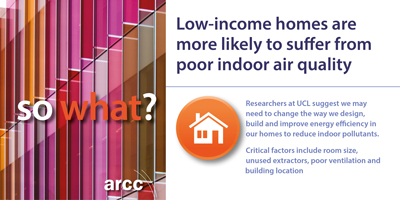Researchers at UCL have found that low-income households are more likely to suffer from poor indoor air quality than high-income households. They suggest we may need to change the way we design, build and improve energy efficiency in our homes to reduce indoor pollutants.
Poor indoor air quality can have serious health impacts, particularly for people who have respiratory related health conditions. One of the key pollutants is ‘particulate matter’. This is a name for tiny particles that can get deep into the lungs and sometimes the bloodstream. Presence of this pollutant has been associated with a number of health problems including increases in asthma, heart attacks and premature death for sufferers of heart or lung disease.
Relevance
Inequalities in health have been increasing in the UK. Those living in the wealthiest areas currently outlive those in the poorest areas by an average of 7 years. The reasons for this are complex and are driven by a number of factors but it is thought that the environment, education, transport, and housing may contribute. Reducing these inequalities is a significant challenge.
Landlords are going to be prevented from letting out the most draughty homes, so many landlords will carry need to out energy efficiency works on their properties. Whilst this will help to bring down residents’ energy bills, if the works are carried out to make the homes ‘air-tight’ without at the same time ensuring there is adequate ventilation, then this could cause an increase in the levels of indoor air pollution and associated health consequences.
Building characteristics that can result in higher levels of indoor air pollution:
- Small rooms
- Non-working/unused kitchen extract and MVHR fans
- Location of home – ventilating a home by opening windows and doors in areas of high levels of outdoor pollution
- Overcrowding
Homes made more ‘air-tight’ to save energy can result in higher indoor temperatures during summer months. For those residents in polluted areas, if they try to dissipate the heat by opening windows, this will increase their exposure to external particulate matter.
Now what?
The homes people live in can have significant impacts on population health. Poor indoor air quality may affect health negatively, particularly when there isn’t enough circulation of air.
There are changes that can be made to homes, as well as changes in people’s use of their homes, that can help prevent negative affects on health. These measures would also reduce exposure to other sources of indoor air pollutants.
Encouraging people to change their habits e.g. using extract fans when cooking, having stricter building regulations on the ventilation efficiency and requiring landlords to regularly maintain ventilation systems will help reduce resident’s exposure to indoor air pollutants.
Across the built environment sector we need to raise awareness of the dangers of omitting a ventilation strategy when making homes air tight in order to increase energy efficiency.
Residents
- If you have trickle vents in your windows, these should be open
- Use extract fan when cooking
- Avoid smoking indoors.
Home owners/landlords
- Make sure your extract fans / ventilation systems are regularly tested and maintained in accordance with manufacturer’s instructions
- If implementing energy efficiency works, make sure a ventilation strategy has been thought through
- If fitting out a kitchen, look for extract fans that automatically operate when the stove is in use.
Government
- Reconsider energy policies and building standards to ensure they encourage adequate ventilation for energy efficiency works that incorporate the tightening of the building envelope
- In light of recent research findings, review the health consequences of energy efficiency policies.
Researchers
- Investigate how the design and performance of buildings themselves ( both before and after energy retrofitting) – as well as the behaviour of occupants – may drive health inequalities between different socioeconomic groups.


